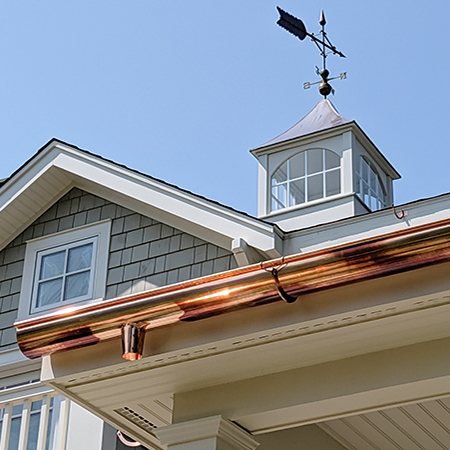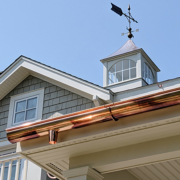
Every house has fascia boards. So what are they? Fascia boards are long wooden boards attached to the rafters on a roof, and they run along the base of the attic. As part of a roof system, gutters mount onto fascia boards, securing them in place. Fascia boards block water from penetrating a roof deck, but they also serve to increase curb appeal.
What Material is Used to Make Fascia Boards?
In residential homes, fascia boards are largely made out of wood. They can be made out of steel or aluminum in some commercial applications. Composite fascia boards are also produced but not commonly used.
What Can Cause Fascia Boards to Fail?
Because residential fascia boards are mostly made out of wood, they are susceptible to deterioration when poor gutter and/or roof conditions allow moisture to persist. This can happen when a roof has not been installed properly. Over time, fascia boards can begin to fail, causing rot. Aging roofs, poorly-designed homes or damaged shingles can also allow unwanted water conditions, causing damage to fascia boards.
What Gutter Problems Can Lead to Fascia Board Failure?
Improperly Installed Gutters
Properly-installed gutters are designed to slope slightly toward their outside edges. In this case, if water overflow occurs it can release away from fascia boards. Improperly-mounted gutter systems, however, can cause water damage to fascia boards by allowing water to flow over the gutters’ inside edges toward fascia boards.
Clogged Gutters or Downspouts
If gutters remain blocked for too long, water can back up and begin to overflow. Downspouts clogged with leaves, sticks and other debris can also cause gutters to back up, resulting in water damage to fascia boards.
Do Compromised Fascia Boards Need to Be Replaced?
Once moisture has penetrated fascia boards, they must be replaced. Fascia board replacement is especially important to prevent further water damage to the walls and foundation of your home.
The Good News About Replacing Fascia Boards
Fascia boards are somewhat easy to replace since they are one of the last materials to be installed on the exterior of a house. To get to fascia boards, the only materials that need to be removed first are gutters.
Prevent Your Fascia Boards From Failing
A solid gutter system combined with proper roof installation will help to prevent fascia boards from eroding. Using the proper nails and fasteners when installing gutters is equally important to prevent gutters from pulling away from fascia boards. When this happens, water can run off behind gutters and bounce onto fascia boards. The following two actions will help to prevent fascia board failure.
Use a Sealant
Protect your fascia boards with a sealer or good quality exterior paint. Fascia boards will unavoidably get wet when precipitation occurs but sealing fascia boards will act as ongoing protective barriers. Bear in mind that as the products wear, you will need to paint or seal your fascia boards again.
Inspect Fascia Boards and Gutters Regularly
Your gutters should be inspected routinely to ensure they are functioning properly. We recommend having them inspected by a licensed professional such as The Gutter Specialist at least twice each year. At that time, your gutter professional will also inspect your fascia boards to determine if they have been subjected to prolonged moisture problems or deterioration. Taking these steps will go a long way toward preventing damage to fascia boards.

The Highest Quality Gutter Protection for Your Home
Call Today: 860-876-2227
Providing gutter installation and maintenance services to New Haven, Middlesex, and New London Counties
© Copyright 2024 The Gutter Specialist, All Rights reserved | Licensed #HIC 0643225 | Fully Insured


